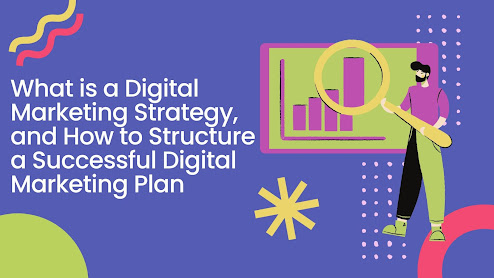What is a Digital Marketing Strategy, and How to Structure a Successful Digital Marketing Plan
1. Introduction to Digital Marketing Strategy: A digital marketing strategy is a comprehensive plan
that outlines how a business or organization will leverage digital channels to
achieve its marketing goals. It involves using various online platforms, tools,
and tactics to reach and engage with the target audience effectively.
2. Defining Objectives and Goals: Start by setting clear and specific objectives for the
digital marketing strategy. These goals could include increasing brand
awareness, driving website traffic, generating leads, boosting sales, or
improving customer retention.
3. Understanding the Target Audience: Conduct in-depth research to understand the target
audience's demographics, interests, online behavior, and preferences. This
insight helps tailor the digital marketing efforts to resonate with the
intended audience.
4. Selecting the Right Digital Channels: Identify the most relevant and effective digital
channels to reach the target audience. This could include search engine
marketing (SEM), social media marketing, email marketing, content marketing,
and others.
5. Crafting Engaging Content: Develop a content strategy that aligns with the
marketing goals and target audience preferences. High-quality, valuable, and
engaging content is crucial for attracting and retaining the audience's attention.
6. Implementing SEO and SEM Strategies: Search engine optimization (SEO) and search engine
marketing (SEM) are vital for improving online visibility and driving organic
and paid traffic to the website.
7. Leveraging Social Media Marketing: Utilize social media platforms to build brand awareness,
engage with the audience, and promote products or services. Tailor the content
to each platform and encourage community interaction.
8. Email Marketing and Automation: Implement email marketing campaigns to nurture leads and maintain customer relationships. Utilize marketing automation to streamline communication and deliver personalized content.
9. Incorporating Digital Advertising: Invest in digital advertising to reach a broader
audience and target specific demographics. Platforms like Google Ads and social
media ads offer various targeting options for optimal results.
10. Analyzing and Measuring Results: Regularly monitor key performance indicators (KPIs) and
use analytics tools to measure the effectiveness of digital marketing efforts.
This data-driven approach helps make informed decisions and optimize the
strategy.
11. Budget Allocation and Resource Planning: Allocate the budget and resources strategically to
different digital marketing channels based on their performance and potential
to meet the set objectives.
12. Continuously Improving and Adapting: Digital marketing is an ever-evolving landscape, so it's
essential to continuously adapt to changes in consumer behavior, technology,
and platforms. Regularly review and refine the digital marketing plan for
ongoing success.
In conclusion, a digital
marketing strategy is a well-structured plan that outlines how a business will
use digital channels to achieve its marketing objectives. By defining clear goals,
understanding the target audience, selecting the right digital channels,
crafting engaging content, implementing SEO and SEM strategies, leveraging
social media, utilizing email marketing, incorporating digital advertising,
analyzing results, budget allocation, and continuous improvement, businesses
can create a successful digital marketing plan that drives growth, enhances
brand visibility, and fosters meaningful connections with the audience in the
digital landscape.




Comments
Post a Comment